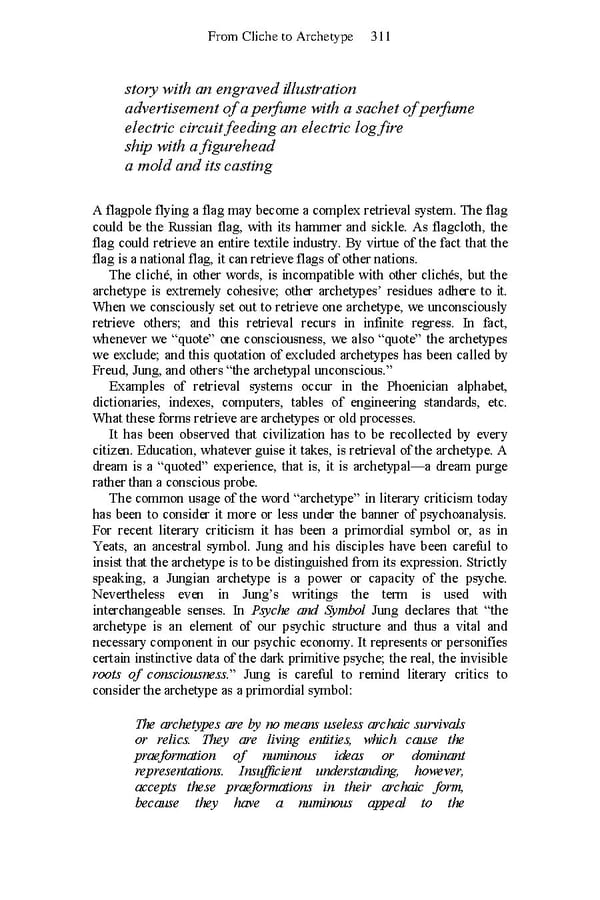From Cliche to Archetype 311 story with an engraved illustration advertisement of a perfume with a sachet of perfume electric circuit feeding an electric log fire ship with a figurehead a mold and its casting A flagpole flying a flag may become a complex retrieval system. The flag could be the Russian flag, with its hammer and sickle. As flagcloth, the flag could retrieve an entire textile industry. By virtue of the fact that the flag is a national flag, it can retrieve flags of other nations. The cliché, in other words, is incompatible with other clichés, but the archetype is extremely cohesive; other archetypes’ residues adhere to it. When we consciously set out to retrieve one archetype, we unconsciously retrieve others; and this retrieval recurs in infinite regress. In fact, whenever we “quote” one consciousness, we also “quote” the archetypes we exclude; and this quotation of excluded archetypes has been called by Freud, Jung, and others “the archetypal unconscious.” Examples of retrieval systems occur in the Phoenician alphabet, dictionaries, indexes, computers, tables of engineering standards, etc. What these forms retrieve are archetypes or old processes. It has been observed that civilization has to be recollected by every citizen. Education, whatever guise it takes, is retrieval of the archetype. A dream is a “quoted” experience, that is, it is archetypal—a dream purge rather than a conscious probe. The common usage of the word “archetype” in literary criticism today has been to consider it more or less under the banner of psychoanalysis. For recent literary criticism it has been a primordial symbol or, as in Yeats, an ancestral symbol. Jung and his disciples have been careful to insist that the archetype is to be distinguished from its expression. Strictly speaking, a Jungian archetype is a power or capacity of the psyche. Nevertheless even in Jung’s writings the term is used with interchangeable senses. In Psyche and Symbol Jung declares that “the archetype is an element of our psychic structure and thus a vital and necessary component in our psychic economy. It represents or personifies certain instinctive data of the dark primitive psyche; the real, the invisible roots of consciousness.” Jung is careful to remind literary critics to consider the archetype as a primordial symbol: The archetypes are by no means useless archaic survivals or relics. They are living entities, which cause the praeformation of numinous ideas or dominant representations. Insufficient understanding, however, accepts these praeformations in their archaic form, because they have a numinous appeal to the
 Essential McLuhan Page 317 Page 319
Essential McLuhan Page 317 Page 319